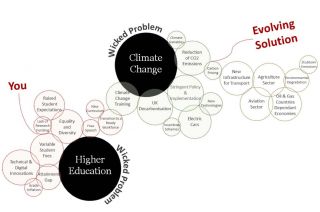
www.buildingsandcities.org/insights/commentaries/academia-climate-change.html
Academia's Critical Role in Climate Change

Providing students with the education and deep understanding of the issues and capabilities is now even more crucial
Edward
Mazria and Lindsay
Rasmussen of Architecture 2030
respond to the B&C special issue EDUCATION
& TRAINING: MAINSTREAMING ZERO CARBON. Professional design schools can provide the leadership needed
to address what is this century's greatest challenge - the preservation of a
habitable planet. Providing
students with new knowledge and capabilities is now even more critical if we are to act responsibly to stay within a 1.5˚C budget. 5 broad challenges for higher education are presented.
We are in the midst of many US and global calamities - climate change, COVID-19, and environmental, racial, and social injustices - each demanding immediate and sustained action. While 2020 has been an extremely challenging year, it has also been a year met by an increased awareness of these issues, as well as new innovations, dialog and achievements in addressing them.
Recent climate action has been motivated by accelerating global climatic impacts and an understanding of the dramatic difference between a 1.5˚C global warming limit and a 2˚C limit, and the global CO2 emission budgets (Rogelj et al., 2018) for meeting the 1.5˚C threshold. According to the IPCC, the global carbon budget, or the total amount of CO2 that can be released into the atmosphere while maintaining a good, or 67% probability, of limiting warming to 1.5˚C is now about 340 GtCO2. To meet this budget, global CO2 emissions must be reduced by 65% by 2030, and CO2 emissions completely phased out by 2040.
The good news is, if we act quickly and responsibly, we can stay within the 1.5˚C budget. We have all the tools, policies, strategies, products, and affordable renewable energy needed to do so as outlined in the International Energy Agency's World Energy Outlook 2020 which tracks energy production and consumption worldwide (Carbon Brief, 2020).
Governments are beginning to address these new targets. In December 2020 the UK Prime Minister announced their new target that aligns with the IPCC SR15 report, calling for a reduction in UK's emissions by at least 68% by 2030, compared to 1990 levels (BEIS, 2020). Bold action is also being taken to address embodied carbon in construction as Oslo, Los Angeles, Mexico City, and Budapest commit to emissions reductions through the C40 Clean Construction Declaration, 'pledging to work with industry to, at a minimum, halve emissions from construction projects in their cities by 2030' (C40, 2020).
While significant action is currently underway in the profession, a paralleled action must now be accelerated within academia. Providing students with the education and deep understanding of the issues and tools they need as they enter the workforce is now even more critical.
Professional design schools are well poised to provide the leadership in higher education needed to address what we deem to be this century's greatest challenge - the preservation of a habitable planet. Schools serve as unique laboratories for structuring an integrated response to complex physical, ecological, social, and economic concerns; and they can do so at a scale that is manageable, yet large enough to make a discernible difference. Focusing on the important role and positive impact education and training plays in meeting the Paris Agreement's targets, addressing current and future climate impacts, and moving beyond zero-carbon to create Carbon Positive and socially just built environments will instill a sense of purpose and excitement in meeting the challenges of our time.
We specifically suggest that professional program core design studios immediately:
- promote a deep understanding of the relationship between built and natural environments
- reach across disciplines to cultivate a broader understanding of design and planning issues and solutions
- engage social and environmental equity issues that recognize the consequences of design decisions
- connect students with the profession by bringing in working professionals actively designing zero carbon buildings
- incorporate zero carbon baseline requirements for all studio design projects.
An abundance of positive examples already exist in both academia and the design professions. The Buildings & Cities special issue shows how education and training can develop 'the capacities, capabilities and competences to rapidly decarbonize both new construction and the existing building stock' (Stevenson and Kwok, 2020). Authors dive into issues of policy and cross-disciplinary collaboration, as well as passive design strategies, embodied carbon and the importance of reuse, recycling, and re-manufacturing of building products. Authors also address the need for addressing issues holistically, expanding beyond fundamentals of zero-carbon design and into social issues. We recommend using this special issue of Buildings & Cities as a stepping point for further action, collaboration, and conversations.
References
BEIS (2020) UK sets ambitious new climate target ahead of UN Summit. Press release from UK Department for Business, Energy and Industrial Strategy. https://www.gov.uk/government/news/uk-sets-ambitious-new-climate-target-ahead-of-un-summit
Carbon Brief (2020). Solar is now 'cheapest electricity in history', confirms IEA. https://www.carbonbrief.org/solar-is-now-cheapest-electricity-in-history-confirms-iea
C40 Cities (2020) Oslo, Los Angeles, Mexico City and Budapest Commit to Clean Construction, Moving the Industry Towards a Sustainable Future. Press release from C40 Cities. https://www.c40.org/press_releases/clean-construction-declaration-launch
Rogelj, J., D. Shindell, K. Jiang, S. Fifita, P. Forster, V. Ginzburg, C. Handa, H. Kheshgi, S. Kobayashi, E. Kriegler, L. Mundaca, R. Séférian, and M.V.Vilariño (2018). Mitigation Pathways Compatible with 1.5°C in the Context of Sustainable Development. In: Global Warming of 1.5°C. An IPCC Special Report on the impacts of global warming of 1.5°C above pre-industrial levels and related global greenhouse gas emission pathways, in the context of strengthening the global response to the threat of climate change, sustainable development, and efforts to eradicate poverty [Masson-Delmotte, V., P. Zhai, H.-O. Pörtner, D. Roberts, J. Skea, P.R. Shukla, A. Pirani, W. Moufouma-Okia, C. Péan, R. Pidcock, S. Connors, J.B.R. Matthews, Y. Chen, X. Zhou, M.I. Gomis, E. Lonnoy, T. Maycock, M. Tignor, and T. Waterfield (eds.)]. Geneva: IPCC and WMO. https://www.ipcc.ch/sr15/
Stevenson, F., & Kwok, A. (2020). Mainstreaming zero carbon: lessons for built-environment education and training. Buildings and Cities, 1(1), pp. 687-696., p. 687. DOI: https://doi.org/10.5334/bc.84
Latest Peer-Reviewed Journal Content
Acceptability of sufficiency consumption policies by Finnish households
E Nuorivaara & S Ahvenharju
Key factors for revitalising heritage buildings through adaptive reuse
É Savoie, J P Sapinski & A-M Laroche
Cooler streets for a cycleable city: assessing policy alignment
C Tang & J Bush
Understanding the embodied carbon credentials of modern methods of construction
R O'Hegarty, A McCarthy, J O'Hagan, T Thanapornpakornsin, S Raffoul & O Kinnane
The changing typology of urban apartment buildings in Aurinkolahti
S Meriläinen & A Tervo
Embodied climate impacts in urban development: a neighbourhood case study
S Sjökvist, N Francart, M Balouktsi & H Birgisdottir
Environmental effects of urban wind energy harvesting: a review
I Tsionas, M laguno-Munitxa & A Stephan
Office environment and employee differences by company health management certification
S Arata, M Sugiuchi, T Ikaga, Y Shiraishi, T Hayashi, S Ando & S Kawakubo
Spatiotemporal evaluation of embodied carbon in urban residential development
I Talvitie, A Amiri & S Junnila
Energy sufficiency in buildings and cities: current research, future directions [editorial]
M Sahakian, T Fawcett & S Darby
Sufficiency, consumption patterns and limits: a survey of French households
J Bouillet & C Grandclément
Health inequalities and indoor environments: research challenges and priorities [editorial]
M Ucci & A Mavrogianni
Operationalising energy sufficiency for low-carbon built environments in urbanising India
A B Lall & G Sethi
Promoting practices of sufficiency: reprogramming resource-intensive material arrangements
T H Christensen, L K Aagaard, A K Juvik, C Samson & K Gram-Hanssen
Culture change in the UK construction industry: an anthropological perspective
I Tellam
Are people willing to share living space? Household preferences in Finland
E Ruokamo, E Kylkilahti, M Lettenmeier & A Toppinen
Towards urban LCA: examining densification alternatives for a residential neighbourhood
M Moisio, E Salmio, T Kaasalainen, S Huuhka, A Räsänen, J Lahdensivu, M Leppänen & P Kuula
A population-level framework to estimate unequal exposure to indoor heat and air pollution
R Cole, C H Simpson, L Ferguson, P Symonds, J Taylor, C Heaviside, P Murage, H L Macintyre, S Hajat, A Mavrogianni & M Davies
Finnish glazed balconies: residents' experience, wellbeing and use
L Jegard, R Castaño-Rosa, S Kilpeläinen & S Pelsmakers
Modelling Nigerian residential dwellings: bottom-up approach and scenario analysis
C C Nwagwu, S Akin & E G Hertwich
Mapping municipal land policies: applications of flexible zoning for densification
V Götze, J-D Gerber & M Jehling
Energy sufficiency and recognition justice: a study of household consumption
A Guilbert
Linking housing, socio-demographic, environmental and mental health data at scale
P Symonds, C H Simpson, G Petrou, L Ferguson, A Mavrogianni & M Davies
Measuring health inequities due to housing characteristics
K Govertsen & M Kane
Provide or prevent? Exploring sufficiency imaginaries within Danish systems of provision
L K Aagaard & T H Christensen
Imagining sufficiency through collective changes as satisfiers
O Moynat & M Sahakian
US urban land-use reform: a strategy for energy sufficiency
Z M Subin, J Lombardi, R Muralidharan, J Korn, J Malik, T Pullen, M Wei & T Hong
Mapping supply chains for energy retrofit
F Wade & Y Han
Operationalising building-related energy sufficiency measures in SMEs
I Fouiteh, J D Cabrera Santelices, A Susini & M K Patel
Promoting neighbourhood sharing: infrastructures of convenience and community
A Huber, H Heinrichs & M Jaeger-Erben
New insights into thermal comfort sufficiency in dwellings
G van Moeseke, D de Grave, A Anciaux, J Sobczak & G Wallenborn
'Rightsize': a housing design game for spatial and energy sufficiency
P Graham, P Nourian, E Warwick & M Gath-Morad
Implementing housing policies for a sufficient lifestyle
M Bagheri, L Roth, L Siebke, C Rohde & H-J Linke
The jobs of climate adaptation
T Denham, L Rickards & O Ajulo
Structural barriers to sufficiency: the contribution of research on elites
M Koch, K Emilsson, J Lee & H Johansson
Disrupting the imaginaries of urban action to deliver just adaptation [editorial]
V Castán-Broto, M Olazabal & G Ziervogel
Nature for resilience reconfigured: global- to-local translation of frames in Africa
K Rochell, H Bulkeley & H Runhaar
How hegemonic discourses of sustainability influence urban climate action
V Castán Broto, L Westman & P Huang
Fabric first: is it still the right approach?
N Eyre, T Fawcett, M Topouzi, G Killip, T Oreszczyn, K Jenkinson & J Rosenow
Social value of the built environment [editorial]
F Samuel & K Watson
Understanding demolition [editorial]
S Huuhka
Data politics in the built environment [editorial]
A Karvonen & T Hargreaves



Latest Commentaries
Decolonising Cities: The Role of Street Naming
During colonialisation, street names were drawn from historical and societal contexts of the colonisers. Street nomenclature deployed by colonial administrators has a role in legitimising historical narratives and decentring local languages, cultures and heritage. Buyana Kareem examines street renaming as an important element of decolonisation.
Integrating Nature into Cities
Increasing vegetation and green and blue spaces in cities can support both climate change mitigation and adaptation goals, while also enhancing biodiversity and ecological health. Maibritt Pedersen Zari (Auckland University of Technology) explains why nature-based solutions (NbS) must be a vital part of urban planning and design.